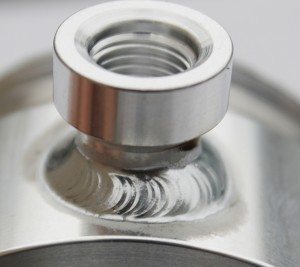TIG Welding: Its Definition, Benefits and Process
 What Is TIG Welding?
What Is TIG Welding?
TIG welding, or Tungsten Inert Gas welding, makes use of a tungsten electrode to heat the metal to be welded and gas to protect the weld puddle from airborne contaminants. A TIG weld produces clean and precise welds on any metal.
Benefits of TIG Welding
• Welds more alloys and metals than other processes — The TIG welding process can be used to weld bronze, brass, copper, magnesium, nickel alloys, aluminum, chromoly, stainless steel, steel, and even gold. TIG is a useful process in welding fenders, door handles, lawn mowers, bike frames, wagons, and more.
• Create clean and high quality welds — With superior arc and weld puddle control, this process can create clean welds when looks count. Since its head input is mostly controlled by pressing a foot pedal, just like driving a car, this process allow you to heat up and cool down the weld puddle to give precise weld bead control. This has made TIG ideal for cosmetic welds like automotive and sculptures.
• No spatter or sparks — Since only the needed amount of filter is added into the welding puddle, there are no sparks or spatter produces, particularly if the metal welded is clean.
• No slag or flux — The Argon gas protects the weld puddle from contamination so there is no flux used or needed in TIG welding equipment. There is also no slag that will block the view on the weld puddle. Further, the finished weld does not have slag to remove in between weld passes.
• No fumes or smoke — TIG welding will not create fumes or smoke, unless its welded base metal has elements or contaminants like zinc, lead, paint, grease or oil. The base metal has to be cleaned prior to welding.
• One shielding gas is used in all applications — Since Argon may be used to TIG weld all metals of varying thicknesses, you will only need a single type of gas in your shop for all of your TIG welding techniques.
• Weld in all positions — TIG welding can be done in all positions — overhead, vertical, horizontal, or flat. It is perfect for roll cages as well as inside confined areas.
How to TIG Weld
1. Make sure that you have the TIG welding machine and all the necessary equipment needed, including clothing. This includes insulating gloves and body protection, welding helmet, safety glasses, and protective clothing.
2. Hold the TIG torch at an angle of about 70 to 80 degrees. Raise the torch so that the tungsten is off of the work piece, but no more than ¼ inch. Make sure that the tungsten does not touch the work piece or it will contaminate your material and you will then have to regrind your tungsten.
3. Practice in controlling the heat with the foot pedal and see the weld puddle increase and decrease. Ideally, the weld puddle has to be about ¼ inch wide. Keep the size consistent so it does not narrow, spread, shrink or grow while you are welding.
4. Hold the filler metal in your other hand at a 15-degree angle from your work piece. Heat up the base metal and dab the filler into the puddle. Dab quickly so you do not leave big deposits.
Choose A Certified TIG Welding Company For Headache Free Tomorrow
If you are looking to get a TIG welding job done, contact a certified welding company to ensure efficient and high quality welds.

 You MUST Ask BEFORE Hiring a Welding Company – So You Can Avoid Wasting Your Time AND Hard-Earned Dollars”
You MUST Ask BEFORE Hiring a Welding Company – So You Can Avoid Wasting Your Time AND Hard-Earned Dollars” 
Keep in Touch